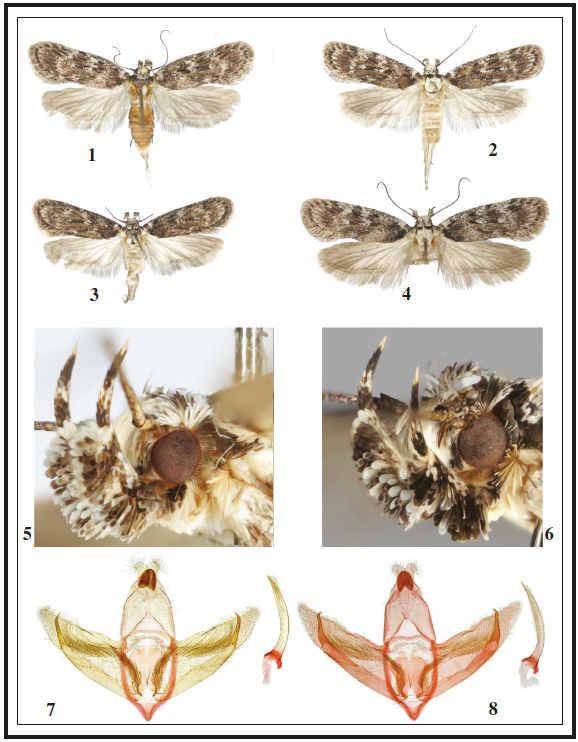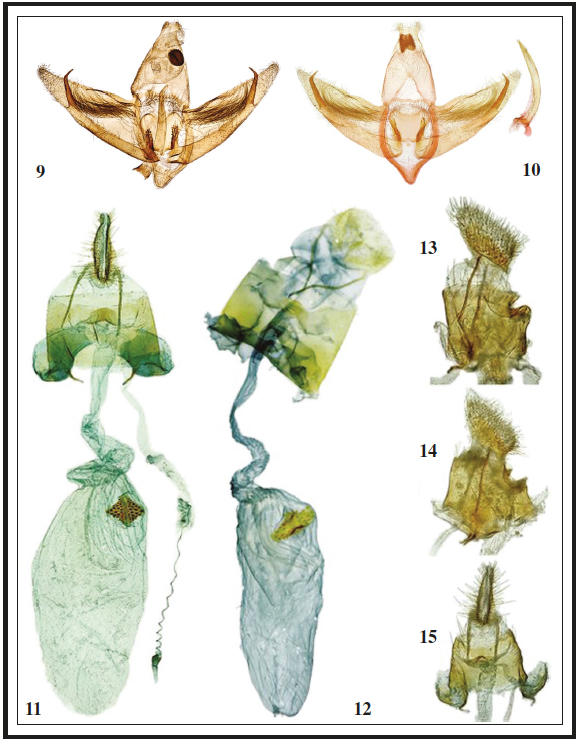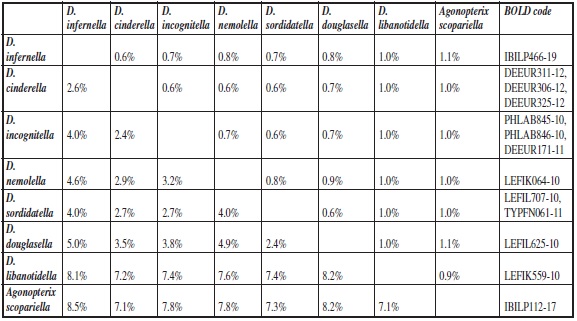

Depressaria infernella Corley & Buchner, a new Iberian species of the Depressaria douglasella group (Lepidoptera: Depressariidae)
Depressaria infernella Corley & Buchner, uma nova espécie ibérica do grupo Depressaria douglasella (Lepidoptera: Depressariidae)
Depressaria infernella Corley & Buchner, una nueva especie ibérica del grupo Depressaria douglasella (Lepidoptera: Depressariidae)
Depressaria infernella Corley & Buchner, a new Iberian species of the Depressaria douglasella group (Lepidoptera: Depressariidae)
SHILAP Revista de Lepidopterología, vol. 47, no. 186, 2019
Sociedad Hispano-Luso-Americana de Lepidopterología
Received: 18/02/2019
Accepted: 03/04/2019
Published: 30/06/2019
Funding
Funding source: Operational Thematic Program for Competitiveness and Internationalization (POCI)
Contract number: POCI-01-0145-FEDER-022127
Award recipient: S. Ferreira
Funding
Funding source: European Union’s Horizon 2020 Research and Innovation Programme
Contract number: 668981
Funding statement: S. F. was funded by the project PORBIOTA-Portuguese E-Infrastructure for Information and Research on Biodiversity (POCI-01-0145-FEDER-022127), supported by Operational Thematic Program for Competitiveness and Internationalization (POCI), under the PORTUGAL 2020 Partnership Agreement, through the European Regional Development Fund (FEDER); this project has also received funding from the European Union’s Horizon 2020 Research and Innovation Programme under grant agreement No 668981.
Abstract: Depressaria infernella, a new species most similar to D. cinderella Corley, 2002 is described from the mountains of north-east Portugal and Sierra de Gredos in Spain. Photos of adults and male and female genitalia of the new species and D. cinderella are given. Morphological and genetic characteristics that demonstrate the distinctiveness of D. infernella from other species of Depressaria are presented.
Keywords: Lepidoptera, Depressariidae, Depressaria, new species, Portugal, Spain.
Resumo: Depressaria infernella, uma nova espécie muito similar a D. cinderella Corley, 2002, é descrita das montanhas do nordeste de Portugal e da Serra de Gredos em Espanha. Os adultos e a genitália do macho e da fêmea da espécie nova e de D. cinderella são ilustradas fotograficamente. As características morfológicas e genéticas que permitem a distinção de D. infernella das restantes espécies de Depressaria são apresentadas.
Palavras-chave: Lepidoptera, Depressariidae, Depressaria, nova espécie, Portugal, Espanha.
Resumen: Se describe Depressaria infernella, una nueva especie muy similar a D. cinderella Corley, 2002 de las montañas del nordeste de Portugal y de la Sierra de Gredos en España. Los adultos y la genitalia del macho y de la hembra de la nueva especie y de D. cinderella son ilustradas fotográficamente. Son presentadas las características morfológicas y genéticas que permiten la distinción de D. infernella de las restantes especies de Depressaria.
Palabras clave: Lepidoptera, Depressariidae, Depressaria, nueva especie, Portugal, España.
Introduction
Within the large and diverse genus Depressaria Haworth, 1811 there are a number of clearly defined groups (HANNEMANN, 1953). One of these is the Depressaria douglasella group, characterised by relatively short forewings with a number of mainly short blackish lines associated with the wing-veins and a pale spot at end of discal cell, male genitalia with clavus and cuiller (a process arising from end of sacculus and directed toward or across the costa of valva), aedeagus without cornuti (HANNEMANN, 1953). In contrast to most Depressaria many of the species do not hibernate in the adult stage (PALM, 1989). There are some fairly easily identified species in the group, but there are also a number of species that present problems of identification. Ideally a full revision of the entire group should be made, but knowledge of the group is too limited for this to be practicable at present. The reasons for this lack of knowledge are outlined below. In the meantime, any additional taxa that can be clearly established will make the ultimate goal of a full revision more feasible, so one such species is described here.
Taxonomic problems in the D. douglasella group stem from several causes. There is a general similarity in external appearance between different species, but there is also a degree of infraspecific variation, not just in external appearance, but also in genitalia. Genitalia differences between species are often slight, particularly in females. More than one species may occur at the same time in a single locality, so that there can be a problem establishing which males and females are conspecific. Some species that have been accepted for many years are in fact junior synonyms, but barcode studies indicate that some of the more widespread species may include additional taxa (P. B., own studies). For a few taxa type material is unavailable. All these factors have contributed to the taxonomic confusion.
The difficult species fall into two subgroups, those including and closely related to D. douglasella Stainton, 1849 and D. sordidatella Tengström, 1848 in which the cuiller is forked at the apex or at least with a small tooth (rarely absent) on the outer margin. These species are for the most part widespread. The D. incognitella subgroup species have a smooth, unforked cuiller; the species mainly inhabit montane areas and have restricted distribution, only D. incognitella Hannemann, 1990 extends from Croatia, Greece, central Italy and the Alps into northern Spain. The other species are D. nemolella Svensson, 1982 (type locality: Sweden, island of Gotland) and D. cinderella Corley, 2002 (Portugal and Spain). In this paper we describe a new species, closely related to D. cinderella, also from Portugal and Spain.
Abbreviations
MFN Museum für Naturkunde, Berlin, Germany
NHMUK Natural History Museum, London, U. K.
NMPC National Museum, Prague, Czech Republic
ZMUC Zoological Museum, Natural History Museum of Denmark, Copenhagen, Denmark
Methods
Most specimens have been captured at 125 w mercury vapour light over a white sheet, with additional material from larvae found by searching in daytime. Dissections were made using standard techniques (ROBINSON, 1976). DNA extraction and sequencing was done following the procedures in CORLEY et al. (2018). The average divergence (uncorrected p-distance) between the sequence of Portuguese specimens and sequences available in BOLD was calculated in MEGA v.5.2.1 (TAMURA et al., 2011).
Depressaria infernella Corley & Buchner, sp. n.
Material examined: Holotype ♂: PORTUGAL, Serra da Estrela, Poço do Inferno, 13-VI. ex l-V- [20]03, M. F. V. Corley, Conopodium. (Foto 6672 ME Depressariinae, P. Buchner). To be deposited in NHMUK.
Paratypes: PORTUGAL, 1 ♂, Serra da Estrela, Poço do Inferno, 9-IX-2001, M. F. V. Corley, gen. prep. 1620 (Corley coll.); 1 ♀, Serra da Estrela, Poço do Inferno, 9-IX-2001, M. F. V. Corley, gen. prep. 1979 (Corley coll.); 1 ♂, Serra da Estrela, Poço do Inferno, 16-VI ex l. V-[20]03, M. F. V. Corley, Conopodium. Corley gen. prep. 1940 (Corley coll.); 2 ♂♂, Serra da Estrela, Poço do Inferno, 18-VI ex l. V-[20]03, M. F. V. Corley, Conopodium. (Fotos 6671, 6675 ME Depressariinae, det./rev. P. Buchner); 1 ♀, Serra da Estrela, Poço do Inferno, 24-VI- ex l. V-[20]03, M. F. V. Corley, Conopodium. Corley gen. prep. 1951 (Corley coll.); 1 ♀, Serra da Estrela, Vale de Zêzere, Albergaria, 1500 m, 5-VIII-2011, M. Corley (Corley coll.). Corley gen. prep. 5653, specimen barcoded (INV00786); 1 ♂, Trás-os-Montes, Serra de Alvão, Arnal, 2-IX-2002, M. F. V. Corley, gen. prep. 1778 (Corley coll.); 1 ♂, Trás-os-Montes, Montalegre, Serra do Larouco, 21-IX-2005, M. F. V. Corley, gen. prep. 2495 (Corley coll.). SPAIN, 1 ♂, Ávila, Sierra de Gredos, 15 km SSW Hoyos del Espinos, 1720 m, 27-28-VII-1988, leg. M. Fibiger, Corley gen. prep 1835 (ZMUC); 1 ♂, Ávila, Sierra de Gredos, 15 km SSW Hoyos del Espinos, 1720 m, 27-28-VII-1988, leg. M. Fibiger. (Foto 2723 ME Depressariinae, det. / rev. P. Buchner). 1 ♂, Prov[incia de] Ávila, S[ier]ra de Gredos, Alman[z]or, 15-20-VII-1999, leg. Dr. U. Koschwitz (MFN) (Foto 6848 ME Depressariinae, det. / rev. P. Buchner); 2 ♀♀, Prov[incia de] Ávila, S[ier]ra de Gredos, Almanzor, 15-20-VII-1999, leg. Dr. U. Koschwitz (MFN) (Fotos 6846, 6847 ME Depressariinae, det. / rev. P. Buchner).
To avoid confusion only dissected specimens have been included as paratypes.
Description: Adult. (Figs 1-3, 5). Wingspan 18-18.5 mm. Head with brownish-black scales with white tips on neck and crown, face white. Labial palp segment 3 four-fifths length of segment 2, segment 2 whitish with two grey-brown bands, outer side with additional grey-brown scales often obscuring bands, upper edge white, segment 3 with two blackish rings, not always distinct due to mixture of whitish and dark brown scales in middle of segment, tip white to buff. Antenna with scape blackish, flagellum dark grey-brown with narrow deep brown rings. Thorax blackish anteriorly, white posteriorly, position of boundary variable, tegulae with some buff scales. Forewing deep grey-brown, with scales more or less tipped blackish; whitish grey scales thinly scattered over most of wing, absent from area between fold and dorsum before middle, more concentrated between cell and costa and at middle of dorsum and forming a spot in middle of cell and a larger one at end, an ill-defined curved fascia beyond end of cell, and a series of spots between veins to termen before terminal spots; blackish brown spots at extreme base of costa and dorsum; white spot on costa following basal spot; black streaks at base of cell and in middle between two whitish cell-spots, another between second cell streak and costa, one on costa at middle, interrupted streaks between veins to costa, narrow streaks between veins to termen, spots on margin between vein-ends from costa at three-quarters around termen; cilia light grey, with deep grey cilia line. Hindwing pale grey, slightly darker posteriorly; cilia light grey with two weak cilia lines; underside with series of blackish spots around termen. Abdomen light grey.
Variation: The appearance of the crown of the head varies according to the length of the white tip of the scales. The extent of white on the thorax also varies according to how far the dark scales extend.
Male genitalia (Figs 7, 8): Gnathos from broad base, slightly longer than wide; socii as wide as long, divergent with shallow notch between them; valva with costal margin slightly convex in basal half, cuiller angled outwards, straight, smooth, tapering evenly, curved inwards just before it crosses costal margin, with about one-fifth of its length projecting beyond costa, pointed; clavus without hairs at base, especially on inner side, otherwise hairy with long hairs exceeding anellus; anellus slightly longer than wide, widest at two-thirds, not or hardly notched at apex; saccus with margins slightly concave, apex rounded; aedeagus slender, slightly curved in basal half, very slightly expanded beyond middle, tapering at four-fifths to parallel-sided apex.

1-3. Depressaria infernella Corley & Buchner, sp. n., paratypes; 4. Depressaria cinderella Corley. 5-6.– Heads: 5. Depressaria infernella Corley & Buchner, sp. n., paratype; 6. Depressaria cinderella Corl 7-8. Male genitalia: 7. Depressaria infernella Corley & Buchner, sp. n., holotype; 8. Depressaria infernella Corley & Buchner, sp. n., paratype.
Female genitalia (Figs 11, 13-15): Apophyses posteriores as long as segment VIII, apophyses anteriores short; segment VIII with characteristic lobes developed antero-laterally, posterior margin slightly concave, anterior margin of tergite VIII deeply excavated; ostium near posterior margin with broad sclerotised curved lip tapering laterally to a narrow fold, in lateral view this lip is strongly protruding; ductus bursae without sclerotisation, posteriorly straight, towards corpus bursae with a single spiral twist, corpus bursae elliptical, signum large, rhomboidal, sometimes folded and then appearing triangular, covered with triangular teeth.

9-10. Depressaria cinderella Corley. 11-15. Female genitalia: 11. Depressaria infernella Corley & Buchner, sp. n., paratypes; 12. Depressaria cinderella Corley, paratype 13-14. Segment VIII, lateral view: Depressaria infernella Corley & Buchner, sp. n., paratypes; 15. Segment VIII, ventral view: Depressaria infernella Corley & Buchner, sp. n., paratype.
Diagnosis: D. infernella and D. cinderella are closely related and occupy nearly contiguous regions. D. infernella is characterised by the deep grey-brown colouring with whitish grey markings. The black streaks are inconspicuous against the dark ground colour. D. cinderella (Figs 4, 6) has similar colouring, but has some whitish scales in area between fold and dorsum and for this reason appears more grey. In male genitalia, D. cinderella differs from D. infernella in the absence of hairs on the clavus (Figs 7-10). Female genitalia differ in the shape of the anterior margin of tergite VIII, deeply excavated in D. infernella, slightly concave in D. cinderella. DNA barcode from the specimen from Serra da Estrela exhibited a distinct haplotype of the partial COI gene sequence with D. cinderella being the most closely related species (uncorrected p-distance 2.7%) and other species including D. douglasella with sequences available with over 3.5% divergence (Table 1).

The number of base differences per site from estimation of net average between groups of sequences are shown. Standard error estimate(s) are shown above the diagonal. The analysis involved 13 nucleotide sequences. Codon positions included were 1st+2nd+3rd+Noncoding. All ambiguous positions were removed for each sequence pair. There were a total of 658 positions in the final dataset. BOLD code: accession codes of BOLD database (http://www.boldsystems.org).
D. incognitella has male genitalia with apical part of cuiller not angled as it crosses costa of valva and not much tapered. D. nemolella has a relatively short and stout aedeagus and hairy clavus not exceeding the anellus. In the female genitalia both D. incognitella and D. nemolella lack the antero-lateral lobes on segment VIII which are present in D. infernella and D. cinderella, although they are not figured in the drawing in CORLEY (2002).
Larvae of D. cinderella have greenish pinacula and feed on basal leaves of Conopodium before flowers are available (CORLEY, 2002). The host-plant Conopodium capillifolium given in CORLEY (2002) is a misidentification, but the Conopodium species in question remains unidentified.
Larva: Final instar. Light green, three dark green dorsal lines; head yellowish with four blackish dots posteriorly; prothoracic plate green, with black “square-bracket” markings on either side posteriorly, reduced to four dots when body retracted, two small < -shaped markings laterally; legs green; anal plate green; pinacula fine, black.
Biology: Host-plant Conopodium majus, feeding from a spinning among stem leaves, flowers or developing seeds. Larvae have been found in late May; adults from late June to September. It has been found at altitudes from 920 m to 1500 m in Portugal, and up to 1800 m in Spain.
Distribution: Currently known from inland northern Portugal from Serra da Estrela (Beira Alta) to Serra do Alvão and Serra do Larouco (Trás-os-Montes) and in Spain in Sierra de Gredos (Ávila).
Etymology: The name infernella is derived from the type locality Poço do Inferno (Well of Hell) in Serra da Estrela, central Portugal, but also reflects the infernally difficult taxonomy of the Depressaria douglasella group.
Acknowledgements
M. C. thanks José Grosso-Silva for introducing him to Poço do Inferno and Fernando Matos for permission to collect Lepidoptera in Parque Natural de Serra da Estrela. We also thank David Lees for the photograph of D. cinderella and the trustees of the NHMUK permission to use this photograph. S. F. was funded by the project PORBIOTA-Portuguese E-Infrastructure for Information and Research on Biodiversity (POCI-01-0145-FEDER-022127), supported by Operational Thematic Program for Competitiveness and Internationalization (POCI), under the PORTUGAL 2020 Partnership Agreement, through the European Regional Development Fund (FEDER); this project has also received funding from the European Union’s Horizon 2020 Research and Innovation Programme under grant agreement No 668981.
BIBLIOGRAPHY
CORLEY, M. F. V., 2002.– Two new species of Depressariidae (Lepidoptera) from Portugal.– Nota lepidopterological, 24: 25-33.
CORLEY, M. F. V., FERREIRA, S., LVOVSKY, A. L., ROSETE, J., 2017.– Borkhausenia crimnodes Meyrick, 1912 (Lepidoptera, Oecophoridae), a southern hemisphere species resident in Portugal.– Nota lepidopterologica, 40(1): 15-24. doi: 10.3897/nl.40.10938.
HANNEMANN, H. J., 1953.– Natürliche Gruppierung der europäischen Arten der Gattung Depressaria s. l. (Lep. Oecoph.).– Mitteilungen aus dem Zoologischen Museum in Berlin, 29: 269-373.
PALM, E., 1989.– Nordeuropas Prydvinger (Lepidoptera: Oecophoridae).– Danmarks Dyreliv, 4: 1-247.
ROBINSON, G. S., 1976.– The preparation of slides of Lepidoptera genitalia with special reference to the Microlepidoptera.– Entomologist’s Gazette, 27: 127-132.
TAMURA, K., PETERSON, D., PETERSON, N., STECHER, G., NEI, M. & KUMAR, S., 2011.– MEGA5: Molecular Evolutionary Genetics Analysis using Maximum Likelihood, Evolutionary Distance, and Maximum Parsimony Methods.– Molecular Biology and Evolution, 28(10): 2731-2739. doi: 10.1093/molbev/msr121.
Author notes
*Autor para la correspondencia / Corresponding author. E-mail: martin.corley@btinternet.com